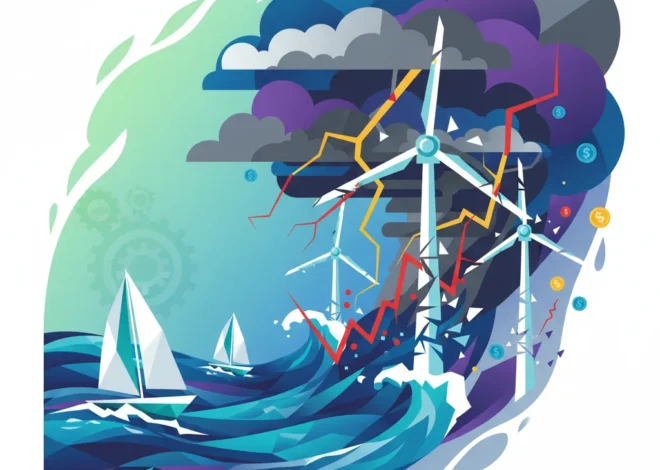
Riding the Economic Tide: Why Tidal Power is the Ultimate Long-Term Investment
The Unseen Force in the Green Energy Revolution
In the relentless pursuit of a stable, green energy future, our attention is often captured by sprawling solar farms and majestic wind turbines. These technologies are crucial pillars of the energy transition, but their inherent intermittency—the sun doesn’t always shine, and the wind doesn’t always blow—creates volatility that sends ripples through our energy grids and financial markets. This unpredictability is a significant challenge for grid operators, the broader economy, and investors seeking stable returns.
However, there is another source of immense, untapped power, one that operates with the clockwork precision of the cosmos itself. In a recent letter to the Financial Times, Kate Gilmartin, CEO of the British Hydropower Association, aptly described tidal power as “the very definition of resilience.” It’s a powerful statement that cuts to the core of what makes this technology a uniquely compelling proposition, not just for environmental sustainability, but for long-term financial strategy and economic stability.
This article delves beyond the surface of tidal energy, exploring the robust financial architecture and compelling economic arguments that position tidal range projects as one of the most resilient and predictable infrastructure investments of the 21st century. For investors, finance professionals, and business leaders, understanding this powerful tide could unlock the next wave of sustainable wealth creation.
What is Tidal Range Power? Predictability as a Financial Asset
Before diving into the numbers, it’s essential to understand what makes tidal range technology different. Unlike tidal *stream* turbines, which are like underwater windmills capturing the speed of flowing water, tidal *range* technology harnesses the *potential energy* of the tide’s height difference. This is typically done by building a barrage or lagoon that captures a large volume of water at high tide and then releases it through turbines as the tide goes out, and vice versa.
The crucial differentiator is its source of power: the gravitational pull of the moon and sun. This is not weather; it’s astrophysics. We can predict tidal patterns with pinpoint accuracy for centuries into the future. For an energy grid struggling with the fluctuating output of other renewables, this is a game-changer. For an investor, this predictability transforms an energy project into a low-volatility, utility-like asset with a guaranteed production schedule. This is the bedrock of its investment case—it removes the single biggest risk factor that plagues other renewable sources.
Benjamin Franklin's Ghost in the Modern Economy: Reviving the Case for a Land Value Tax
The Investment Thesis: A Century of Predictable Returns
The financial world thrives on predictability. From algorithmic trading to long-term portfolio allocation, the ability to accurately forecast future cash flows is paramount. It is in this arena that tidal range energy presents a uniquely powerful value proposition, fundamentally different from almost any other asset in the energy stock market.
1. Ultra-Long Asset Lifespan
While solar panels have a lifespan of 25-30 years and wind turbines around 20-25 years, tidal barrages are civil engineering projects built to last. The world’s first commercial tidal power station, La Rance in France, has been operating since 1966 and is projected to continue for many more decades. New projects are being designed with operational lifespans of 120 years or more. This longevity means that once the initial capital expenditure is overcome, the asset can generate returns for multiple generations, making it an ideal match for pension funds, sovereign wealth funds, and insurance companies with long-term liabilities.
2. Low and Stable Operating Costs
Tidal projects have extremely high upfront construction costs, which has historically been their main barrier. However, once built, their operational expenditure (OpEx) is remarkably low and predictable. There are no fuel costs, and the heavy-duty, slow-moving turbines require less frequent maintenance than their high-RPM wind counterparts. This cost structure—high CapEx, low OpEx—is the hallmark of classic infrastructure investments like toll roads and bridges, known for providing stable, inflation-hedged returns.
3. De-Risking the Energy Portfolio
For a national grid or a large energy utility, tidal power acts as a powerful stabilizing force. It provides a consistent, baseload-like power source that can be ramped up or down at predictable times. This reduces reliance on expensive gas-peaker plants, which are often fired up to cover shortfalls from intermittent renewables, thereby lowering overall system costs and reducing price volatility in the energy market. This grid-level benefit creates a secure revenue stream for the tidal asset, as its output is highly valuable for maintaining a stable economy.
To put this in perspective, let’s compare tidal range with its more famous renewable counterparts across key investment metrics.
| Metric | Tidal Range | Offshore Wind | Solar PV (Utility-Scale) |
|---|---|---|---|
| Predictability | Excellent (Astronomical, predictable years in advance) | Moderate (Weather-dependent, predictable hours/days in advance) | Good (Diurnal/seasonal, but cloud-cover dependent) |
| Asset Lifespan | 120+ years | 20-30 years | 25-30 years |
| Capacity Factor | 25-35% (Consistent and predictable) | 40-60% (Variable and unpredictable) | 15-25% (Variable and unpredictable) |
| Key Financial Challenge | Very High Upfront Capital (CapEx) | High Maintenance (OpEx) & Intermittency | Land Use & Grid Integration Costs |
| Best Fit for Investor | Long-horizon, low-risk tolerance (e.g., Pension Funds) | Medium-horizon, moderate risk tolerance | Short-to-medium horizon, technology-risk tolerant |
Data synthesized from sources including the International Renewable Energy Agency (IRENA) and industry analysis. Capacity factors are illustrative and vary by location.
The EU's Innovation Paradox: Is Regulation Strangling the Future of Finance?
This is where innovative finance and financial technology must step in. We need new models for public-private partnerships, government-backed revenue guarantees (like Contracts for Difference), and perhaps even tokenization. Could blockchain be used to create fractional ownership of a multi-billion-dollar tidal lagoon, allowing smaller institutional investors or even community funds to participate? It’s a forward-thinking idea, but these are the kinds of conversations we need to be having to unlock the capital required for these nation-building, century-spanning projects. The tide won’t wait for our financial systems to catch up.
Financing the Future: Overcoming the Capital Hurdle
The elephant in the room is, of course, the monumental upfront cost. A large-scale tidal lagoon can cost billions of dollars. This is not a project for venture capital; it’s a project for global capital markets, sovereign wealth, and national banking infrastructure. Success hinges on a stable and supportive policy environment.
Governments play a pivotal role by creating a regulatory framework that provides long-term revenue certainty. This is crucial for attracting the kind of patient capital required. Mechanisms could include:
- Regulated Asset Base (RAB) Model: This model, often used for funding utilities, provides a regulated return on the capital invested, significantly de-risking the project for equity and debt holders.
- Contracts for Difference (CfD): These government-backed contracts guarantee a fixed price for the electricity produced, protecting the project from wholesale market price fluctuations.
- Green Bonds: Issuing government-backed or corporate green bonds specifically for tidal projects can tap into the rapidly growing ESG (Environmental, Social, and Governance) investing market.
Beyond government support, the project’s inherent resilience offers unique benefits. Its predictable output makes it an ideal anchor for powering large-scale industrial processes or even energy-intensive data centers for the fintech industry. These long-term Power Purchase Agreements (PPAs) with private companies can provide an additional, stable revenue layer that makes the project more attractive to financiers.
The AI Paradox: How Technology Can Restore the Human Touch to Recruitment and Drive Economic Growth
Conclusion: A Legacy Investment for a Resilient Economy
Tidal power is more than just another renewable energy source. It is a long-term investment in economic resilience, grid stability, and energy independence. Its primary product isn’t just kilowatts; it’s certainty. In a world grappling with climate change, geopolitical energy shocks, and market volatility, the value of that certainty cannot be overstated.
As Kate Gilmartin highlighted, tidal power is the “definition of resilience.” For the finance and investment community, it represents a rare opportunity to build a legacy asset that will deliver predictable, inflation-protected returns for over a century while making a profound contribution to a stable, decarbonized economy. It’s time to stop seeing the high upfront cost as a barrier and start seeing it as a down payment on 120 years of predictable green energy and stable financial returns. The tide is turning, and savvy investors should be ready to ride the wave.


